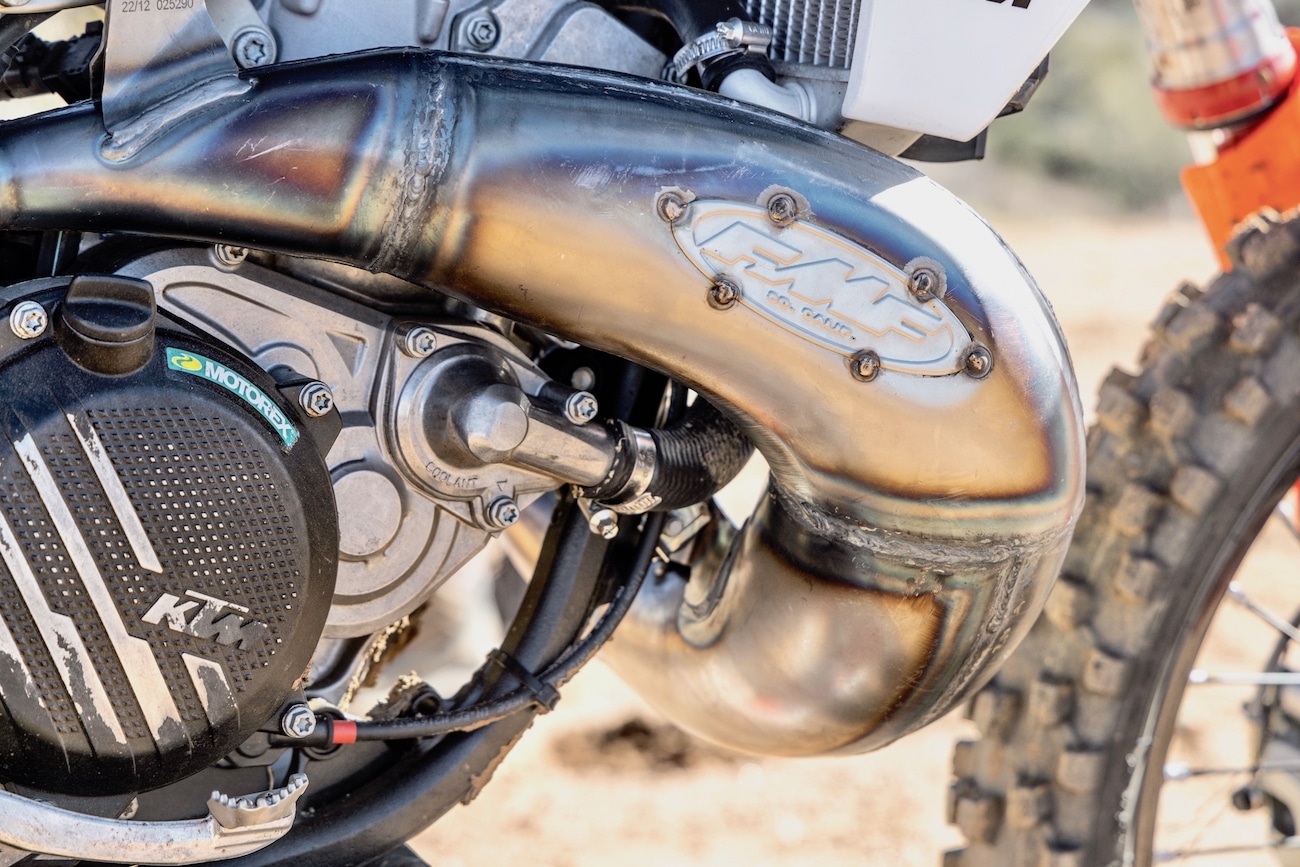MXA TEAM TESTED: FMF 2023 KTM 250/300SX PIPE/SILENCER
WHAT IS IT? The Fatty pipe is the staple power puncher in FMF’s two-stroke lineup, and the titanium Powercore 2.1 is their latest and greatest silencer.
WHAT’S IT COST? $299.99 (Factory Fatty pipe), $229.99 (Powercore 2.1), $449.99 (titanium Power Core 2.1 silencer).
CONTACT? www.fmfracing.com or (310) 631-4363.
WHAT STANDS OUT? Here’s a list of things that stand out with the FMF Racing Factory Fatty pipe and titanium Powercore 2.1 silencers.
(1) Applications. The FMF Racing Factory Fatty pipe and titanium Powercore 2.1 silencer fit on the 2023 KTM 250SX, 250XC, 300SX and 300XC models. Plus, they fit on the 2023 Husqvarna TC250 and TX300 two-strokes. We tested the FMF pipe and silencer on two bikes for this test, the 300SX and TC250.
(2) Stock trim. The 2023 KTM 300SX is an all-new bike, and it ranks as the “second-most asked-about bike of the year,” just behind the Yamaha YZ450F. Because the TBI (throttle body injected) two-strokes are radically different from carbureted two-stroke engines, aftermarket brands have been slow to produce upgraded parts. The FMF pipe/silencer combo is the first aftermarket engine upgrade we’ve tried on our new TC250 and 300SX two-strokes.
On the track, the stock KTM 300SX pipe and silencer create a more linear power when compared to the FMF pipe. They have less bottom hit with more of a “luggy” feel in the low-to-mid power range. The Husqvarna TC250 runs cleaner than the 300SX in stock form and doesn’t have the same “lug” feel, but it still has a smoother bottom-end feel than carbureted two-strokes.
(3) KTM 300SX dyno comparison. On the dyno, the stock KTM 300SX peaked at 54.96 horsepower at 8560 rpm (in the green map). The power comes on strong down low, and the rate of increase starts to lessen at 7500 rpm. With the Factory Fatty pipe and titanium Powercore 2.1 silencer, the KTM 300SX has slightly less power from 5800 to 6700 rpm, but then it pulls away from the stock setup in the top-end power range. While the stock setup starts to peter out at 7500 rpm, the FMF-equipped 300SX continues to pull to 8800 rpm, reaching an impressive 58.08 horsepower. That’s an increase of a little more than 3 horsepower for $750—impressive for bolt-on power.
As for torque, the story is more of the same. The stock 300SX has a peak of 35.38 pound-feet of torque, peaking at 7450 rpm. The FMF system boosts torque and extends it to 36.10 pound-feet at 7750 rpm.
(4) Husqvarna TC250 dyno comparison. The stock 2023 Husqvarna TC250 peaks at 52.12 horsepower (in the green map) at 8600 rpm; however, the dyno curve wasn’t perfectly linear. The stock setup had a slight dip in the power from 7600 to 8000. With the FMF pipe and silencer, the TC250 dyno curve was smoother, without any dips or surges. It also pulled to 8800 rpm with a peak of 53.38—just over 1 horsepower stronger than stock. As for torque, the FMF pipe boosted it from 32.17 pound-feet at 8150 rpm to 32.40 pound-feet at 8250 rpm.
(5) FMF Performance. Although the dyno shows the FMF and stock pipe and silencers being almost identical on the bottom end on both the 300SX and TC250, all of our testers felt that the FMF system offered more snap and bottom-end hit in the dirt. The FMF system also gave us a cleaner and livelier feel right at the crack of the throttle. And, that lively character lasted throughout the powerband while maintaining good connectivity at the rear wheel. The FMF system made it easier to use third gear in the corners on the 300SX, giving us 450 four-stroke vibes. Although the TC250 is significantly lower in power and torque, the FMF system also helped it ride a gear higher in the turns.
We also tested the Powercore 2.1 silencer with the stock pipe with the TC250. Without the Factory Fatty pipe, the TC250 had less snap on the bottom, but the silencer did increase mid- and high-end power, which is good for dry and slick conditions when it’s harder to find traction.
WHAT’S THE SQUAWK? No complaints.
MXA RATING: FMF found more power on the KTM 300SX, and their setup was equally impressive on the TC250. Our favorite aspect of the FMF system was that it gave our fuel-injected two-strokes the crisp and clean-revving feel that was previously absent in stock form.









Comments are closed.